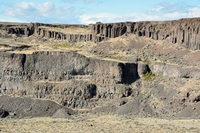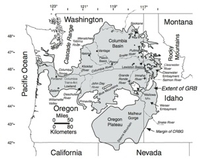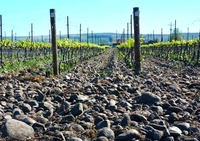Geology, however, is not just the study of rocks and their derivative soils. The study of geology encompasses the natural upheavals that have created the wild diversity of landforms of the earth. It requires an understanding not only of the forces that create and destroy the earth’s surface, but also of geologic time. The geologist must understand that these formidable powers are active every day but are rarely fully comprehended because they happen so slowly when compared to a human’s lifespan. It is natural for a human to assume the earth is entirely stable and unchanging because the geological processes span many human lifetimes.
Geology informs not just of the rocks underlying the hillside, but why the hillside is there at all. Which of nature’s powers combined to create the topography we observe today? If the soil is heavy with clay, how did the clay get there? It’s not enough to know what is; we want to know why it is as well. In this essay, we will explore the geology of a now well-known wine producing region.
The vineyards of Oregon and Washington are integral to understanding the subject of modern United States wine. That was not always the case. Even in 1980, there were only about 60 bonded wineries in Oregon and Washington combined. Compare that to the over 2000 wineries today and the growth of the region is impressive. This is clearly a habitat that benefits wine grapes and some of that beneficial environment is strongly influenced by the geology.
A geologic event that has had a great impact on vineyards of the Pacific northwest is the eruption of vast volumes of lava that created the Columbia Plateau. Much of the vineyard area in the combined states is influenced by the underlying geology of the Columbia River Basalt. This eruption was a rare geologic event. There are other flood basalts in Siberia, China and India, but they are all much older than the Columbia River basalts, which are the largest such feature on the North American continent. The Columbia River basalts cover some 81 thousand square miles and contain over fifty thousand cubic miles of rock. The enormous volume of lava erupted on the surface likely caused the land to subside as the subterranean magma chamber emptied onto the surface. This sinking caused the formation of thick basalt sequences that we can see today.

There are two general categories of lavas, those that erupt with forceful explosive power, like the 1980 eruption of Mt. St. Helens in Washington State and those that erupt in a more subdued fashion, like Kilauea which is continually erupting on the big island of Hawai’i. The difference in eruptive style is closely tied to the properties of the magma beneath the volcanic vent. Those with more silica in their composition – felsic in the geologic parlance – tend to be more “sticky” and viscous and erupt with greater explosive force. Those with more magnesium and iron (ferric) components – mafic to geologists – will tend to be less viscous and flow rather than explode.
How did the Columbia River basalt get there? It is thought by many to be the result of a “hot spot” or plume of magma. Deep beneath the earth’s surface, the heat and pressure are sufficient to begin a partial melting of the rocks. Each mineral within a rock has a different melting point, so those with lower melting points (starting at around 1300° F) begin the process. After 20% of the rock mass melts, it becomes liquid and is capable of flowing. Volcanoes are vents that allow magma to travel to the surface. They form at points of weakness in the crust, often where fractures disrupt the strength of the earth’s surface.
These lower viscosity lavas become the dark-colored basalts of the world. The Columbia River Basalt Group originated as massive lava flows beginning around 17 million years ago and lasting for around 10 million years. Most of the volume of lava erupted in a 1.1 million year period from volcanic vents along what is now the Oregon-Washington-Idaho border. The lava flows erupted as flood basalts, which moved quickly across the landscape, perhaps as rapidly as 15 miles an hour. It must have been an amazing phenomenon to watch.
As the flows moved across the surface, they crossed the burgeoning Cascade Range and spread across much of the Willamette Valley. From the Willamette, the flows continued westward, across the Coast Range and into the Pacific Ocean where they advanced across the continental shelf.

All this outpouring of lava has transformed the landscape of the region and created a unique environment for wine grapes. Although much of the Columbia Valley AVA is basalt overlain with a thick layer of loess, there are areas where the basaltic bedrock is exposed and valued for its heat retention and greater iron content. One particular site is the Rocks District of Milton-Freewater, on the Oregon side Walla Walla Valley. This distinctive AVA is based on the presence of basalt cobbles in the soil.
The Walla Walla River tumbles down from the Blue Mountains at a steep gradient and fans out when it reaches the valley floor. As the water velocity decreases at this point, the carrying capacity drops as well and the river can no longer transport the large basalt cobbles. The river alters its course and leaves the cobbles behind. Thus, the soils derived from the old riverbed are marked by the distinctive dark basalt cobbles on the surface. Underneath are well drained gravels that allow vine roots to penetrate deep into the substrate. The dark soils absorb heat and allow the vines to bud earlier and often ripen more fully than nearby sites.

In the Willamette Valley of Oregon, there are many remnants of the Columbia River basalts. Time has eroded some of the rocks, but the Dundee Hills, Chehalem Mountains and Eola-Amity Hills are all noted for the basaltic underpinnings of their soils. There are distinct differences among soil types throughout the Willamette Valley. The famous Jory soil that is found in the Willamette is based on the Columbia River basalt and was declared the Official State Soil of Oregon. The deep red color is identified with some of the most famous sites for Pinot Noir in Oregon. Domaine Drouhin, Eyrie, Bethel Heights and Cristom are only a few of the many famous wineries that benefit from the basalt-based soils. It can make for delicious comparison to try wines from basalt soils next to those grown nearby, but on lighter colored, marine sedimentary soils.
If you have the chance to visit the Willamette Valley or Walla Walla Valley, take a closer look at the soils. If you drive along the Columbia River on the Oregon-Washington border, you will definitely be surrounded by the Columbia River basalts. Imagine them in a molten state, flowing at 10-15 miles an hour down the valley. It’s not an event we are likely to experience in our lifetimes, but it did happen in the recent geologic past. It forms a unique American terroir.
